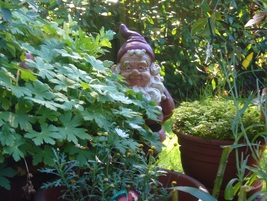 This Gnome has escaped from the garden shed.
This Gnome has escaped from the garden shed. 2013 was marked at the Chelsea Flower Show’s 100th anniversary by an ‘amnesty’ for garden gnomes. They have been brought out of the shed and become, if only temporarily, respectable.
Origins of the Garden Gnome
The Romans were keen to have stone statues of their gods in their gardens. During the Renaissance, gardens featured stone ‘grotesques’ which were often brightly painted.
The origin of the modern garden gnome is thought to be German. ‘Little folk’ or dwarves were said to work down the mines and help around the farms in German literature. Having garden dwarfs or garten zwerg in the house and garden was thought to bring luck to the home. An industry of ceramic, porcelain and terracotta indoor and outdoor dwarves, which were carefully painted, became a trade in areas of Germany such as Dresden.
It is unclear when the first German dwarf arrived in England or why, when they did, they were named 'gnomes'. The oldest garden gnome (Lampy) dates back to the 1870’s and resides at Lamport Hall in Northamptonshire.
In the first decade of the 20th Century gnomes became a popular feature of country house gardens and even appeared at the 1912 International Horticultural Exhibition, precursor to the modern-day Chelsea Flower Show. The gnome lost popularity with the onset of the First World War.
It was Walt Disney who revived the fashion for gnomes and dwarves with the animated film, Snow White and the Seven Dwarfs. The result was that the 1970s became the heyday of the British garden gnome, often of the plastic variety.
The Garden Gnome in Folklore and Literature
The word ‘gnome’ comes from the Latin word, gnomus, which first appears in the works of 16th century Swiss alchemist Paracelsius and may mean ‘earth dweller’. Earth-dwelling spirits are mentioned in numerous ancient and medieval mythologies, often guarding mines and precious underground treasures, mainly in German and Greek literature.
Is There a Future for Gnomes ?
Yes, of course. It’s time to let them out of your garden shed and in to your garden.
References
Way, T. Garden Gnomes: A History. Published by Shire Pubns, 2009. ISBN 10: 0747807108 / ISBN 13: 9780747807100.
"Gnome". Oxford English Dictionary (3rd ed.). Oxford University Press. September 2005.
Lewis, C S (1964). The Discarded Image - An Introduction to Medieval and Renaissance Literature. Cambridge University Press. p. 135. ISBN 0-521-47735-2.
Huygen, W. & Poortvliet, R. Gnomes. 1977. Harry N. Abrams. ISBN 0810909650.
See:
http://www.pinterest.com/dinahparums/amnesty-for-gnomes-by-dinah-parums/
Origins of the Garden Gnome
The Romans were keen to have stone statues of their gods in their gardens. During the Renaissance, gardens featured stone ‘grotesques’ which were often brightly painted.
The origin of the modern garden gnome is thought to be German. ‘Little folk’ or dwarves were said to work down the mines and help around the farms in German literature. Having garden dwarfs or garten zwerg in the house and garden was thought to bring luck to the home. An industry of ceramic, porcelain and terracotta indoor and outdoor dwarves, which were carefully painted, became a trade in areas of Germany such as Dresden.
It is unclear when the first German dwarf arrived in England or why, when they did, they were named 'gnomes'. The oldest garden gnome (Lampy) dates back to the 1870’s and resides at Lamport Hall in Northamptonshire.
In the first decade of the 20th Century gnomes became a popular feature of country house gardens and even appeared at the 1912 International Horticultural Exhibition, precursor to the modern-day Chelsea Flower Show. The gnome lost popularity with the onset of the First World War.
It was Walt Disney who revived the fashion for gnomes and dwarves with the animated film, Snow White and the Seven Dwarfs. The result was that the 1970s became the heyday of the British garden gnome, often of the plastic variety.
The Garden Gnome in Folklore and Literature
The word ‘gnome’ comes from the Latin word, gnomus, which first appears in the works of 16th century Swiss alchemist Paracelsius and may mean ‘earth dweller’. Earth-dwelling spirits are mentioned in numerous ancient and medieval mythologies, often guarding mines and precious underground treasures, mainly in German and Greek literature.
Is There a Future for Gnomes ?
Yes, of course. It’s time to let them out of your garden shed and in to your garden.
References
Way, T. Garden Gnomes: A History. Published by Shire Pubns, 2009. ISBN 10: 0747807108 / ISBN 13: 9780747807100.
"Gnome". Oxford English Dictionary (3rd ed.). Oxford University Press. September 2005.
Lewis, C S (1964). The Discarded Image - An Introduction to Medieval and Renaissance Literature. Cambridge University Press. p. 135. ISBN 0-521-47735-2.
Huygen, W. & Poortvliet, R. Gnomes. 1977. Harry N. Abrams. ISBN 0810909650.
See:
http://www.pinterest.com/dinahparums/amnesty-for-gnomes-by-dinah-parums/
 RSS Feed
RSS Feed